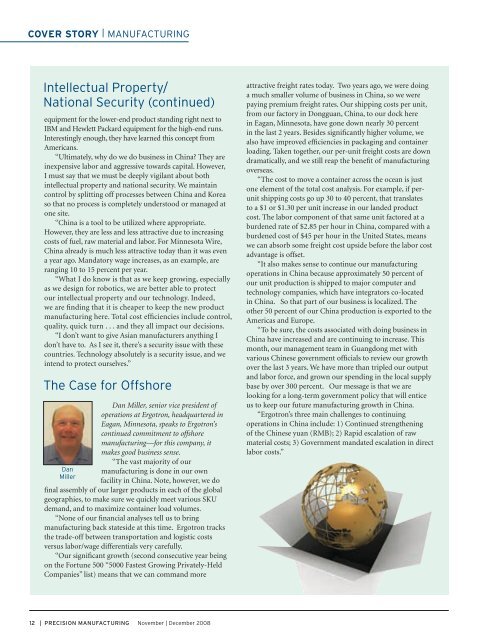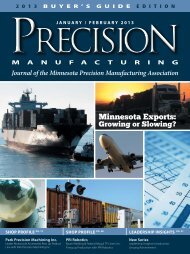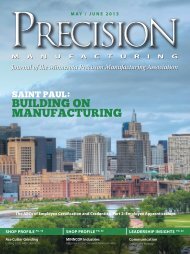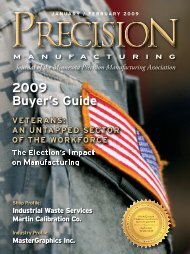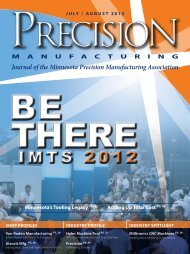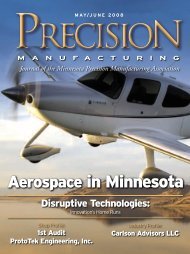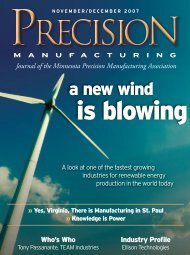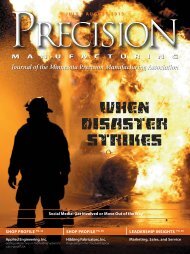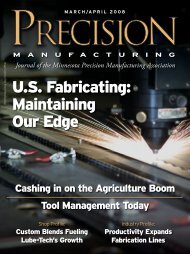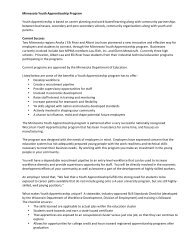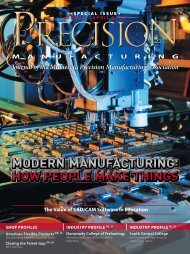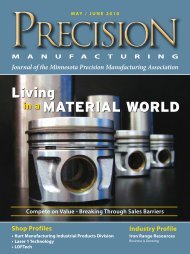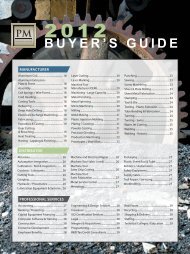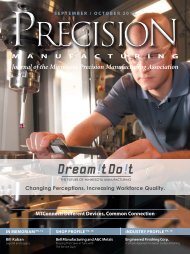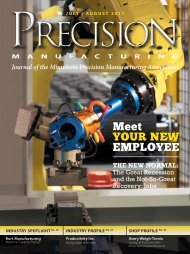November / December - Minnesota Precision Manufacturing ...
November / December - Minnesota Precision Manufacturing ...
November / December - Minnesota Precision Manufacturing ...
Create successful ePaper yourself
Turn your PDF publications into a flip-book with our unique Google optimized e-Paper software.
COVER STORY | MANUFACTURING<br />
Intellectual Property/<br />
National Security (continued)<br />
equipment for the lower-end product standing right next to<br />
IBM and Hewlett Packard equipment for the high-end runs.<br />
Interestingly enough, they have learned this concept from<br />
Americans.<br />
“Ultimately, why do we do business in China? They are<br />
inexpensive labor and aggressive towards capital. However,<br />
I must say that we must be deeply vigilant about both<br />
intellectual property and national security. We maintain<br />
control by splitting off processes between China and Korea<br />
so that no process is completely understood or managed at<br />
one site.<br />
“China is a tool to be utilized where appropriate.<br />
However, they are less and less attractive due to increasing<br />
costs of fuel, raw material and labor. For <strong>Minnesota</strong> Wire,<br />
China already is much less attractive today than it was even<br />
a year ago. Mandatory wage increases, as an example, are<br />
ranging 10 to 15 percent per year.<br />
“What I do know is that as we keep growing, especially<br />
as we design for robotics, we are better able to protect<br />
our intellectual property and our technology. Indeed,<br />
we are finding that it is cheaper to keep the new product<br />
manufacturing here. Total cost efficiencies include control,<br />
quality, quick turn . . . and they all impact our decisions.<br />
“I don’t want to give Asian manufacturers anything I<br />
don’t have to. As I see it, there’s a security issue with these<br />
countries. Technology absolutely is a security issue, and we<br />
intend to protect ourselves.”<br />
The Case for Offshore<br />
Dan<br />
Miller<br />
Dan Miller, senior vice president of<br />
operations at Ergotron, headquartered in<br />
Eagan, <strong>Minnesota</strong>, speaks to Ergotron’s<br />
continued commitment to offshore<br />
manufacturing—for this company, it<br />
makes good business sense.<br />
“The vast majority of our<br />
manufacturing is done in our own<br />
facility in China. Note, however, we do<br />
final assembly of our larger products in each of the global<br />
geographies, to make sure we quickly meet various SKU<br />
demand, and to maximize container load volumes.<br />
“None of our financial analyses tell us to bring<br />
manufacturing back stateside at this time. Ergotron tracks<br />
the trade-off between transportation and logistic costs<br />
versus labor/wage differentials very carefully.<br />
“Our significant growth (second consecutive year being<br />
on the Fortune 500 “5000 Fastest Growing Privately-Held<br />
Companies” list) means that we can command more<br />
attractive freight rates today. Two years ago, we were doing<br />
a much smaller volume of business in China, so we were<br />
paying premium freight rates. Our shipping costs per unit,<br />
from our factory in Dongguan, China, to our dock here<br />
in Eagan, <strong>Minnesota</strong>, have gone down nearly 30 percent<br />
in the last 2 years. Besides significantly higher volume, we<br />
also have improved efficiencies in packaging and container<br />
loading. Taken together, our per-unit freight costs are down<br />
dramatically, and we still reap the benefit of manufacturing<br />
overseas.<br />
“The cost to move a container across the ocean is just<br />
one element of the total cost analysis. For example, if perunit<br />
shipping costs go up 30 to 40 percent, that translates<br />
to a $1 or $1.30 per unit increase in our landed product<br />
cost. The labor component of that same unit factored at a<br />
burdened rate of $2.85 per hour in China, compared with a<br />
burdened cost of $45 per hour in the United States, means<br />
we can absorb some freight cost upside before the labor cost<br />
advantage is offset.<br />
“It also makes sense to continue our manufacturing<br />
operations in China because approximately 50 percent of<br />
our unit production is shipped to major computer and<br />
technology companies, which have integrators co-located<br />
in China. So that part of our business is localized. The<br />
other 50 percent of our China production is exported to the<br />
Americas and Europe.<br />
“To be sure, the costs associated with doing business in<br />
China have increased and are continuing to increase. This<br />
month, our management team in Guangdong met with<br />
various Chinese government officials to review our growth<br />
over the last 3 years. We have more than tripled our output<br />
and labor force, and grown our spending in the local supply<br />
base by over 300 percent. Our message is that we are<br />
looking for a long-term government policy that will entice<br />
us to keep our future manufacturing growth in China.<br />
“Ergotron’s three main challenges to continuing<br />
operations in China include: 1) Continued strengthening<br />
of the Chinese yuan (RMB); 2) Rapid escalation of raw<br />
material costs; 3) Government mandated escalation in direct<br />
labor costs.”<br />
12 | PRECISION MANUFACTURING <strong>November</strong> | <strong>December</strong> 2008


